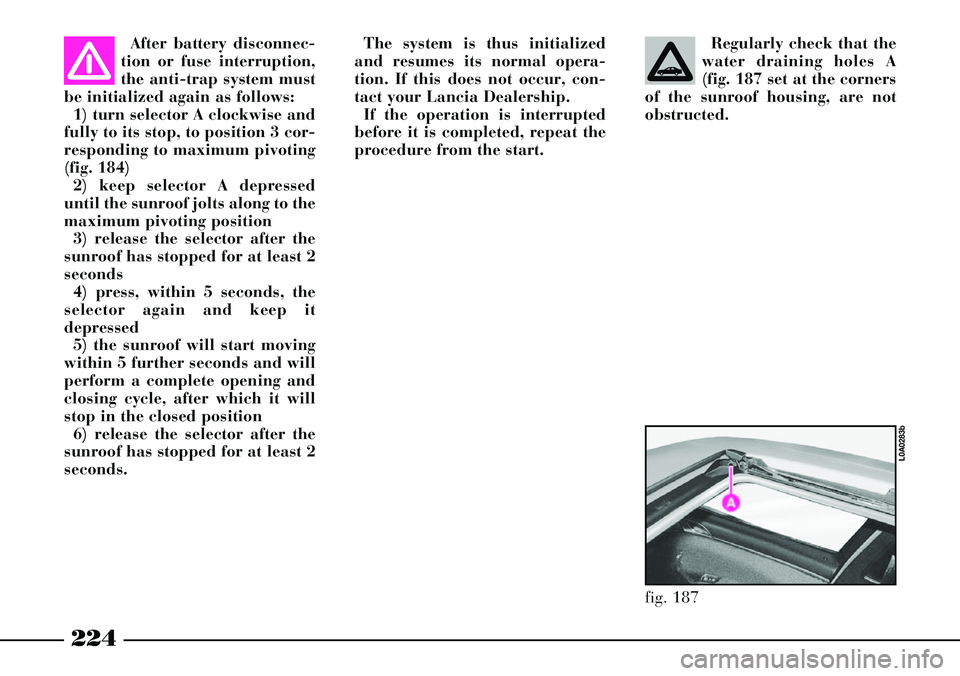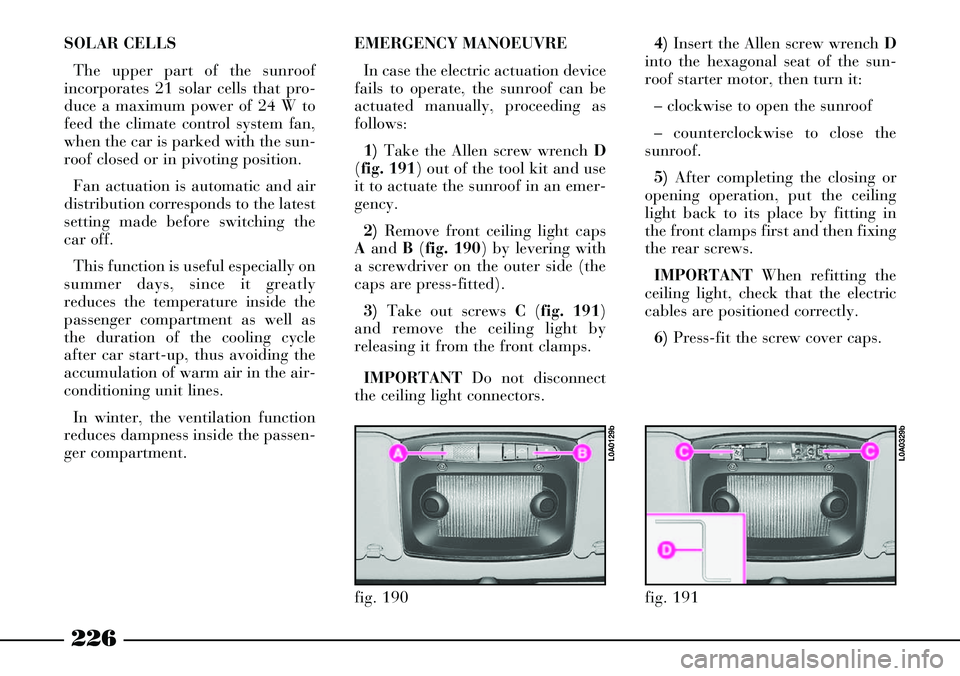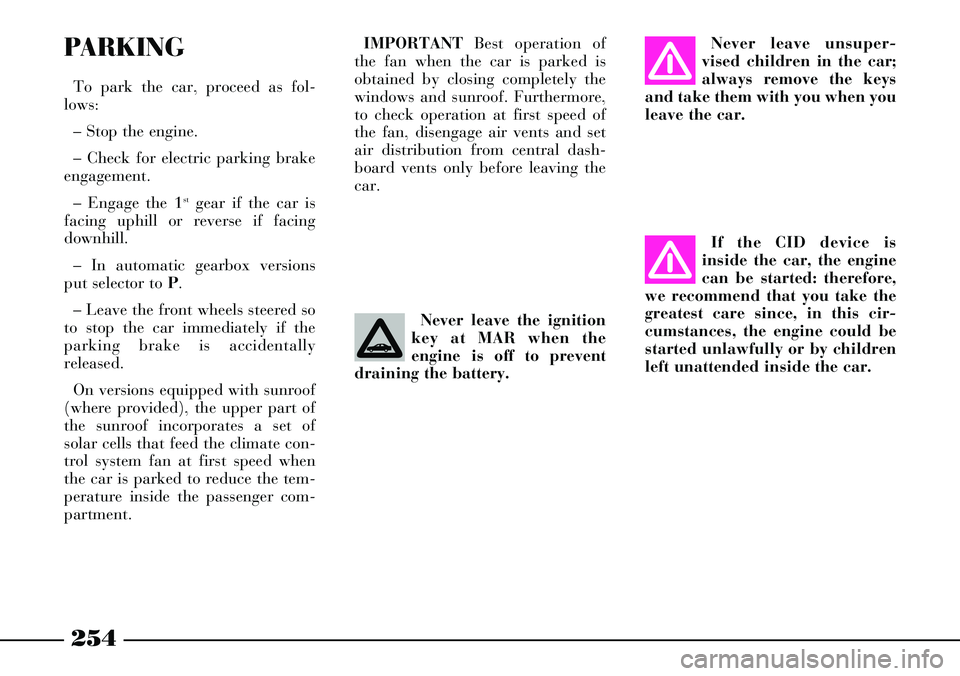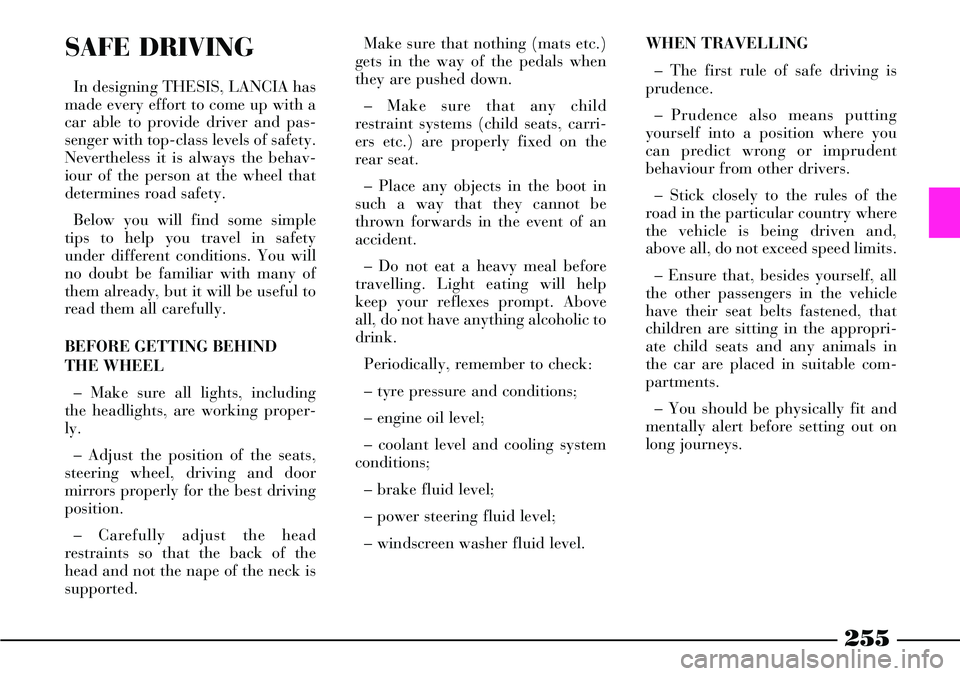Check Lancia Thesis 2007 Owner handbook (in English)
[x] Cancel search | Manufacturer: LANCIA, Model Year: 2007, Model line: Thesis, Model: Lancia Thesis 2007Pages: 386, PDF Size: 8.69 MB
Page 225 of 386

224
After battery disconnec-
tion or fuse interruption,
the anti-trap system must
be initialized again as follows:
1) turn selector A clockwise and
fully to its stop, to position 3 cor-
responding to maximum pivoting
(fig. 184)
2) keep selector A depressed
until the sunroof jolts along to the
maximum pivoting position
3) release the selector after the
sunroof has stopped for at least 2
seconds
4) press, within 5 seconds, the
selector again and keep it
depressed
5) the sunroof will start moving
within 5 further seconds and will
perform a complete opening and
closing cycle, after which it will
stop in the closed position
6) release the selector after the
sunroof has stopped for at least 2
seconds.The system is thus initialized
and resumes its normal opera-
tion. If this does not occur, con-
tact your Lancia Dealership.
If the operation is interrupted
before it is completed, repeat the
procedure from the start.Regularly check that the
water draining holes A
(fig. 187 set at the corners
of the sunroof housing, are not
obstructed.
fig. 187
L0A0283b
Page 227 of 386

226
SOLAR CELLS
The upper part of the sunroof
incorporates 21 solar cells that pro-
duce a maximum power of 24 W to
feed the climate control system fan,
when the car is parked with the sun-
roof closed or in pivoting position.
Fan actuation is automatic and air
distribution corresponds to the latest
setting made before switching the
car off.
This function is useful especially on
summer days, since it greatly
reduces the temperature inside the
passenger compartment as well as
the duration of the cooling cycle
after car start-up, thus avoiding the
accumulation of warm air in the air-
conditioning unit lines.
In winter, the ventilation function
reduces dampness inside the passen-
ger compartment.EMERGENCY MANOEUVRE
In case the electric actuation device
fails to operate, the sunroof can be
actuated manually, proceeding as
follows:
1)Take the Allen screw wrench D
(fig. 191) out of the tool kit and use
it to actuate the sunroof in an emer-
gency.
2)Remove front ceiling light caps
Aand B(fig. 190) by levering with
a screwdriver on the outer side (the
caps are press-fitted).
3)Take out screws C(fig. 191)
and remove the ceiling light by
releasing it from the front clamps.
IMPORTANTDo not disconnect
the ceiling light connectors.4)Insert the Allen screw wrench D
into the hexagonal seat of the sun-
roof starter motor, then turn it:
– clockwise to open the sunroof
– counterclockwise to close the
sunroof.
5)After completing the closing or
opening operation, put the ceiling
light back to its place by fitting in
the front clamps first and then fixing
the rear screws.
IMPORTANTWhen refitting the
ceiling light, check that the electric
cables are positioned correctly.
6)Press-fit the screw cover caps.
fig. 190
L0A0129b
fig. 191
L0A0329b
Page 239 of 386

238
If repairs need to be car-
ried out inside the engine
compartment when this is
still hot, be careful not to burn
yourself and keep away from the
electric fan as this may cut in at
any time, even if the key is
removed from the ignition switch.
Wait until the engine has cooled.
Scarves, ties and other
loose articles of clothing
could easily get caught up
in moving parts.To close the bonnet:
Lower the bonnet at approx. 20 cm
from the engine compartment and
then let it drop, ensuring that it is
fully closed and not just held in posi-
tion by the safety catch. If the bonnet
does not close properly do not push it
down but open it again and repeat the
above procedure.
For safety reasons the
bonnet shall always be
perfectly closed when trav-
elling. Always check for proper
bonnet locking. If the bonnet is left
inadvertently open, stop the car
immediately and close the bonnet.FUEL FILLER CAP
The fuel filler cap flap is controlled
automatically controlled by the cen-
tral door locking system.
When central door locking is on,
the fuel filler flap cannot be opened;
when central door locking is off, the
flap can be opened by simply press-
ing on the front part in point A(fig.
215).
Open the fuel filler flap by turning
it in the direction shown by the
arrow until it is completely opened.
fig. 215
L0A0012b
Page 242 of 386

241
After travelling a few
kilometres, check that the
screws securing the rack
are tight.
Distribuite the load
evenly and remember,
when driving the car, that
the car is now more susceptible to
side wind.
Never exceed the per-
mitted weights (refer to
the “Technical specifica-
tions” chapter).ROOF RACK –
SKI RACK
ANCHORAGE POINTS
The car roof features four brackets
for anchoring the roof rack/ski rack
(fig. 219); these brackets are hidden
by small covers.
To use the brackets, lift the covers
by levering on point A(fig. 220).
Fasten the roof rack/ski rack to the
brackets, by following the provided
instructions.After removing the roof rack/ski
rack, lower the covers by engaging
them into their seats.
IMPORTANTStrictly comply with
the law regulations in force concern-
ing maximum overall dimensions.
Strictly follow the assembly
instructions provided with the roof
rack/ski rack set. Assembly should
be made by qualified personnel.
fig. 219
L0A0083b
fig. 220
L0A0084b
Page 243 of 386

HEADLIGHTS
GAS-DISCHARGE (BI-XENO)
MAIN BEAM / DIPPED BEAM
HEADLIGHTS AND DYNAMIC
BEAM ADJUSTMENT DEVICE
These headlights, called Bi-Xeno,
use a lamp with a xenon-filled bulb,
both for the dipped beam and the
main beam headlights.
The main characteristics of this
type of headlights are:
– higher brilliancy
– higher light beam width and
adjustability
– lower consumption under work-
ing conditions
– longer bulb life.Each headlight is equipped with an
electronic control unit used to con-
trol supply voltage. Due to high bril-
liancy, bi-Xeno headlights require
the adoption of a dynamic beam
adjustment control system.
This system is controlled by an
electronic control unit operating at
two levels:
– constant headlight beam realign-
ment as a function of the car load
– dynamic headlight beam align-
ment to compensate car pitching
when running.Operation
Light is projected onto the road by
means of a spherical glass lens with
a large surface (70 mm diameter).
A deflector lifts and lowers, so that
light distribution is different for
both the main beam and dipped
beam headlights. The deflector is
electrically operated and the
mechanical lifting/lowering opera-
tion is performed real-time when
lights are switched.
The xenon lamp consists of a bulb
containing low-pressure xenon and
two electrodes.
To obtain light emission, an elec-
tric arc must be triggered between
the two electrodes and maintained.
Each headlight is equipped with a
control unit which:
– checks the voltage/current value
under working operation
– triggers the arc to the electrodes
and cause salt evaporation at
switching on.
242
Page 246 of 386

245
EOBD SYSTEM
The EOBD (European On Board
Diagnosis) system continuously
monitors the engine emission system
components. Furthermore, the sys-
tem warns the driver of deterioration
concerning the emission system
components by means of the instru-
ment panel warning light Ucoming
on with message “ENGINE CON-
TROL SYSTEM FAULT”.The objective is to:
– monitor system efficiency;
– warn when failures can increase
emissions over the threshold estab-
lished by the European regulations;
– warn of the need to replace dete-
riorated components.
Furthermore, the system is
equipped with a connector for inter-
facing with specific tools used to
read the error codes stored in the
control unit memory along with a set
of diagnostic and engine specific
parameters. This check can also be
performed by traffic controller
agents.Contact a Lancia
Dealership as soon as
possible if the instrument
panel Uwarning light either
does not come on when the key is
turned to MAR or comes on, with
fixed or flashing light, when trav-
elling together with message
“ENGINE CONTROL SYSTEM
FAULT”. Warning light Uoper-
ation can be checked by traffic
controller agents. Comply with
the regulations in force in the
country where you are travelling.
IMPORTANTAfter eliminating
the problem, your Lancia
Dealershipwill run a bench test to
fully check the system. In some
cases, a long road test may be
required.
Page 248 of 386

247
The car is fitted with an
electronic brake force
distributor (EBD). The x
and >warning lights come on at
the same time on the multifunc-
tion display, together with mes-
sage “EBD SYSTEM FAULT”,
when the engine is running to
indicate that there is an EBD sys-
tem failure. In this case violent
braking may be accompanied by
early rear wheel locking with the
possibility of skidding. Drive the
car extremely carefully to the
nearest Lancia Dealership to
have the system checked.
If warning light x
comes on together with
message “LOW BRAKE
FLUID LEVEL”, on the multi-
function display, stop the car
immediately and contact a Lancia
Dealership. Fluid leakage will
compromise efficiency of both the
traditional brake system and the
ABS system.The system performance
in terms of active safety
must not lead the driver
to take unnecessary or unjusti-
fied risks. Always suit your dri-
ving style to the weather, visibili-
ty and traffic conditions.
Excessive use of engine
braking (gears tooshort
and limited grip) may
make the wheels slip. The ABS
will have no effect on this type of
skidding.
The maximum possible
deceleration always
depends on the available
road grip. Obviously, grip will be
considerably decreased in the
presence of snow and ice. In these
conditions, the braking space
will still be high, even with the
ABS.The coming on of the
>warning light on the
multifunction display,
together with message “ABS SYS-
TEM FAULT”, when the engine is
running, normally indicates a
fault in the ABS system. In this
case the braking system will still
be effective although without the
anti-lock device assistance. In
these conditions, EBD system
operation may also be reduced.
Drive the car extremely carefully
to the nearest Lancia Dealership
to have the ABS system checked.
Page 254 of 386

253
Remember that until the
engine has started, the
brake booster and power
steering systems will not work
and a greater effort will therefore
be required to press the brake
pedal and turn the steering
wheel. For cars equipped with
turbosupercharger in
particular, but generally
for any kind of cars, avoid abrupt
accelerations immediately before
turning the engine off. A quick
burst on the accelerator serves
absolutely no practical purpose,
wastes fuel and may damage seri-
ously the turbosupercharger
rotor bearings.EMERGENCY START-UP
If the Lancia CODE system fails to
recognise that code transmitted by
the ignition key (symbol Ytogeth-
er with message “VEHICLE PRO-
TECTION SYSTEM FAULT” on the
multifunction display) the emer-
gency start-up can be performed by
using the CODE card code.
For the correct procedure see chap-
ter “In an emergency”.
Before opening the lug-
gage compartment bonnet
to reload the battery or to
connect an auxiliary battery,
carefully read and comply with
the instructions contained in the
paragraph “If battery is to be dis-
connected” in the chapter “In an
emergency”. Never bump start the
engine (by pushing, tow-
ing or coasting downhill)
as this could cause fuel to flow
into the catalytic exhaust system
and damage it beyond repair.
IMPORTANTIf the engine turns
off while the car is running, the
Lancia CODE symbol Yand the
message “VEHICLE PROTECTION
SYSTEM FAULT” may appear on
the multifunction display when the
engine starts again. In this case
check that the warning light switch-
es off when turning the engine off
and on again with the car stationary.
Otherwise contact aLancia
Dealership.
Page 255 of 386

254
Never leave unsuper-
vised children in the car;
always remove the keys
and take them with you when you
leave the car.
If the CID device is
inside the car, the engine
can be started: therefore,
we recommend that you take the
greatest care since, in this cir-
cumstances, the engine could be
started unlawfully or by children
left unattended inside the car.PARKING
To park the car, proceed as fol-
lows:
– Stop the engine.
– Check for electric parking brake
engagement.
– Engage the 1
stgear if the car is
facing uphill or reverse if facing
downhill.
– In automatic gearbox versions
put selector to P.
– Leave the front wheels steered so
to stop the car immediately if the
parking brake is accidentally
released.
On versions equipped with sunroof
(where provided), the upper part of
the sunroof incorporates a set of
solar cells that feed the climate con-
trol system fan at first speed when
the car is parked to reduce the tem-
perature inside the passenger com-
partment.Never leave the ignition
key at MAR when the
engine is off to prevent
draining the battery.
IMPORTANT Best operation of
the fan when the car is parked is
obtained by closing completely the
windows and sunroof. Furthermore,
to check operation at first speed of
the fan, disengage air vents and set
air distribution from central dash-
board vents only before leaving the
car.
Page 256 of 386

255
SAFE DRIVING
In designing THESIS, LANCIA has
made every effort to come up with a
car able to provide driver and pas-
senger with top-class levels of safety.
Nevertheless it is always the behav-
iour of the person at the wheel that
determines road safety.
Below you will find some simple
tips to help you travel in safety
under different conditions. You will
no doubt be familiar with many of
them already, but it will be useful to
read them all carefully.
BEFORE GETTING BEHIND
THE WHEEL
– Make sure all lights, including
the headlights, are working proper-
ly.
– Adjust the position of the seats,
steering wheel, driving and door
mirrors properly for the best driving
position.
– Carefully adjust the head
restraints so that the back of the
head and not the nape of the neck is
supported. Make sure that nothing (mats etc.)
gets in the way of the pedals when
they are pushed down.
– Make sure that any child
restraint systems (child seats, carri-
ers etc.) are properly fixed on the
rear seat.
– Place any objects in the boot in
such a way that they cannot be
thrown forwards in the event of an
accident.
– Do not eat a heavy meal before
travelling. Light eating will help
keep your reflexes prompt. Above
all, do not have anything alcoholic to
drink.
Periodically, remember to check:
– tyre pressure and conditions;
– engine oil level;
– coolant level and cooling system
conditions;
– brake fluid level;
– power steering fluid level;
– windscreen washer fluid level. WHEN TRAVELLING
– The first rule of safe driving is
prudence.
– Prudence also means putting
yourself into a position where you
can predict wrong or imprudent
behaviour from other drivers.
– Stick closely to the rules of the
road in the particular country where
the vehicle is being driven and,
above all, do not exceed speed limits.
– Ensure that, besides yourself, all
the other passengers in the vehicle
have their seat belts fastened, that
children are sitting in the appropri-
ate child seats and any animals in
the car are placed in suitable com-
partments.
– You should be physically fit and
mentally alert before setting out on
long journeys.